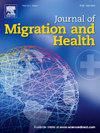Proportional representation and incidence rate of repeat visits in ethnic minorities compared to native Dutch people under the age of 25 years in the Netherlands
IF 2.9
Q1 PUBLIC, ENVIRONMENTAL & OCCUPATIONAL HEALTH
引用次数: 0
Abstract
Introduction
Migration is a growing phenomenon and has impact on sexual and reproductive health outcomes, such as an increased burden for STIs, sexual violence and unintended pregnancies. Equitable access to sexual health care is of great importance for young people from ethnic minorities (EMs). In this study, we aimed to determine the proportional representation of first- and second generation EMs under 25 years at Dutch Sexual Health Centers (SHCs) compared to native Dutch citizens.
Methods
In this retrospective cohort study, coded health records data of 270,927 persons in the age group of 15 till 24 years visiting SHCs between 2016 and 2021 were included. Health records data was combined with census tract data (Statistics Netherlands) to average annual calculate consultation rates, i.e., dividing 6-year-average of the number of first consultations of a patient in the study period belonging to a specific EM by the total number of citizens in the age group of 15 till 24 years belonging to that EM in the Netherlands in 2021, multiplied by 1000.
Results
The consultation rate for native Dutch patients was 22.0 per 1000 persons (95 %CI: 21.8–22.2, 18.9, 19.8 (95 %CI: 19.8–20.4) for first-generation EMs and 18.4 (95 %CI: 18.0–18.8) for second-generation EMs. In both first- and second generation EMs, consultation rates for patients from Turkey, Morocco, Eastern Europe and Asia were lower than for native Dutch patients. Consultation rates among patients from Africa were lower for first-generation EMs than native Dutch patients. Consultation rates among patients from Indonesia, Suriname/Dutch Antilles, Latin America and other western countries were equal or higher than among native Dutch patients
Discussion
Our study showed that several EMs were underserved in Dutch sexual health care, suggesting lower access to care and indicating the need for culturally sensitive approaches to increase access. Using consultation rates is informative to indicate inequalities in access to sexual health care among EMs.
与荷兰25岁以下的荷兰本地人相比,少数民族的比例代表性和重复就诊的发生率
移徙是一种日益严重的现象,对性健康和生殖健康结果产生了影响,例如增加了性传播感染、性暴力和意外怀孕的负担。公平获得性保健服务对少数民族青年非常重要。在本研究中,我们旨在确定25岁以下荷兰性健康中心(SHCs)的第一代和第二代新兴市场的比例代表与荷兰本土公民的比例。方法回顾性队列研究纳入2016年至2021年期间在小健康中心就诊的年龄在15 ~ 24岁的270,927人的编码健康记录数据。将健康记录数据与人口普查区数据(荷兰统计局)相结合,以平均每年计算会诊率,即,将研究期间属于特定EM的患者首次会诊次数的6年平均值除以2021年荷兰属于该EM的15至24岁年龄组公民总数乘以1000。结果荷兰本土患者的咨询率为22.0 / 1000 (95% CI: 21.8-22.2, 18.9, 19.8 (95% CI: 19.8 - 20.4)),第一代EMs为18.4 (95% CI: 18.0-18.8)。在第一代和第二代新兴市场中,来自土耳其、摩洛哥、东欧和亚洲的患者的咨询率低于荷兰本土患者。来自非洲的第一代急诊患者的问诊率低于荷兰本土患者。来自印度尼西亚、苏里南/荷属安的列斯群岛、拉丁美洲和其他西方国家的患者的咨询率与荷兰本土患者相同或更高。讨论我们的研究表明,荷兰的一些新兴市场在性健康保健方面服务不足,这表明获得护理的机会较少,并表明需要采取文化敏感的方法来增加获得性保健的机会。使用咨询率说明了新兴市场在获得性保健方面的不平等。
本文章由计算机程序翻译,如有差异,请以英文原文为准。
求助全文
约1分钟内获得全文
求助全文
来源期刊

Journal of Migration and Health
Social Sciences-Sociology and Political Science
CiteScore
5.70
自引率
8.70%
发文量
65
审稿时长
153 days
 求助内容:
求助内容: 应助结果提醒方式:
应助结果提醒方式:


